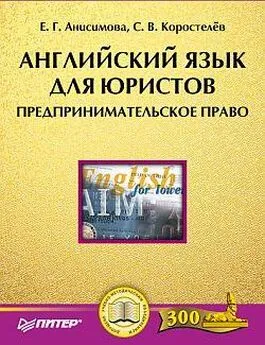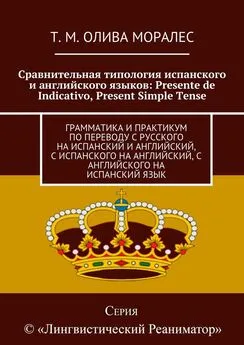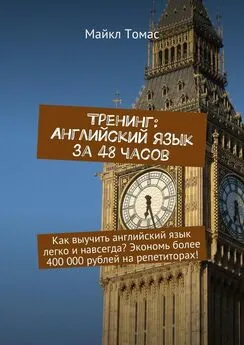Станислав Коростелев - Английский язык для юристов. Предпринимательское право
- Название:Английский язык для юристов. Предпринимательское право
- Автор:
- Жанр:
- Издательство:046ebc0b-b024-102a-94d5-07de47c81719
- Год:2006
- Город:СПб
- ISBN:5-469-01382-0
- Рейтинг:
- Избранное:Добавить в избранное
-
Отзывы:
-
Ваша оценка:
Станислав Коростелев - Английский язык для юристов. Предпринимательское право краткое содержание
Настоящее учебное пособие предназначено для овладения лексикой в области предпринимательского и коммерческого права студентами лингвистических вузов и студентами гражданско-правовой специализации юридических вузов.
Книга призвана дать преподавателям и студентам специальный языковой и профессиональный материал, ориентированный на повышение качества профессиональной подготовки в области правовой лингвистики и международного бизнеса.
Английский язык для юристов. Предпринимательское право - читать онлайн бесплатно ознакомительный отрывок
Интервал:
Закладка:
If a waiver of notice or protest is stated on the face of the instrument, it is binding upon all parties; when written above the signature of an endorser, it binds only the endorser.
Exercise 1. Comprehension questions:
1. What is a shelter provision designed for?
2. When can be personal defence used?
3. In what way may be the contract breached?
4. When does the holder have notice of a claim or defence?
5. What is the difference between lack of consideration and failure of consideration?
6. What are the kinds of frauds?
7. When does the drawer have the defence of conditional delivery?
8. In what case a person is not liable on negotiable instrument?
9. What should be done to be sure that a drawer would be liable on an instrument?
Exercise 2. Find in the text English equivalents to the following:
Отпадение основания договора; законный владелец; недостаточность возмещения; правовая защита против ограниченного круга держателей ценных бумаг; предъявление векселя к акцепту или оплате; первичное обязательство; опротестовывать вексель; универсальная защита против неограниченного круга держателей ценных бумаг; субсидиарная ответственность.
Exercise 3. Consult recommended dictionaries and give words or phrases to the following definitions:
Приобретательная давность; непрерывно владеть; давность владения; течение срока; истечение срока; наличие вины; непреодолимая сила; чрезвычайные и непреодолимые обстоятельства.
Exercise 4. Be ready to talk on one of the following topics:
1. Describe the special protection given to a holder in due course.
2. Name six personal defenses.
3. Explain the significance of a real defense.
4. Name six real defenses.
5. Differentiate between primary liability and secondary liability.
Exercise 5. Make up your own dialog on the case: In Norman v. World Distributors, Inc., the court stressed that the purchaser of the note «knew enough of the seller's referral plan to require it to inquire further» and secondly that he knew that the seller had been doing business under three different names during the year in which the note was transferred. Those two facts in addition to a substantial discount led the court to find the purchaser was not a holder in due course.
Unit 14
Checks and Bank Collections
Чеки и инкассирование
Чеком признается ценная бумага, содержащая ничем не обусловленное распоряжение чекодателя банку произвести платеж указанной в нем суммы чекодержателю (п. 1 ст. 877 ГК).
Законодательство и практика чекового обращения знает несколько разновидностей чеков: по субъектам различаются чеки предъявительские, ордерные и именные; с точки зрения инкассации (получения денег) чеки подразделяются на кассовые, расчетные и кроссированные.
Участниками отношений по чеку являются чекодатель, чекодержатель и плательщик. Чекодателем считается лицо, выписавшее чек; чекодержателем – лицо, являющееся владельцем выписанного чека. Плательщиком по чеку является банк, где чекодатель имеет средства, которыми он вправе распоряжаться путем выставления чеков (это могут быть деньги, находящиеся на банковском счете, учтенный вексель, даже открытый кредит). Использование чеков в качестве инструмента безналичных расчетов должно основываться на чековом договоре между плательщиком и его банком, а также между банками – участниками чековых расчетов.
– bank draft – тратта, выставленная одним банком на другой
– cashier's check – чек, выписанный банком на себя
– certified check – удостоверенный чек (с надписью банка о принятии к платежу)
– collecting bank – банк-инкассатор
– depositary bank – банк-депозитарий
– electronic fund transfers (EFTs) – система электронного перевода платежей
– forgery – подлог или подделка документа
– intermediary bank – банк-посредник
– overdraft – овердрафт (сумма, получаемая по чеку сверх остатка на текущем счете); превышение кредита (в банке)
– payor bank – банк-плательщик
– presenting bank – банк-представитель
– remitting bank – банк, переводящий средства
– stale check – просроченный чек
– subrogation – суброгация; замена одного кредитора другим
– teller's check – чек, выписанный банком на другой банк и подписанный кассиром банка, выписавшего чек
– traveler's check – дорожный чек
– uttering – переуступка; выпуск в обращение; сбыт
A check is a draft drawn on a bank and payable on demand. It is the most common form of a draft. It is drawn on a bank by a drawer who has an account with the bank to the order of a specified person or business named on the check or to the bearer. A check is a safe means of transferring money, and it serves as a receipt after it has been paid and canceled by the bank.
In the check shown in Figure 1, Ms. Sharova is the drawer; she has an account in the Sun Trust Bank. John Doe is the payee. Sun Trust Bank, on which the check is drawn, is the drawee.

Ownership of a check may be transferred to another person by endorsement by the payee. In this manner, a check may circulate among several parties, taking the place of money. A bank must honor a check when it is properly drawn against a credit balance of the drawer. Failure to do so would make the bank liable to the drawer for resulting damages.
Special types of checks have been developed for use in particular situations. These checks include bank drafts, traveler's checks, and cashier's checks.
A bank draft, sometimes called a teller's check, or treasurer's check, is a check drawn by one bank on another bank in which it has funds on deposit in favor of a third person, the payee. Many banks deposit money in banks in other areas for the convenience of depositors who depend upon the transfer of funds when transacting business in distant places. When the buyer is unknown to the seller, such checks are more acceptable than personal checks.
A cashier's check is a check drawn by a bank upon itself. The bank, in effect, lends its credit to the purchaser of the check. People who will not accept personal checks will often accept cashier's checks. Such a check may be made payable either to the depositor, who purchases it from the bank, or to the person who is to cash it. If the check is made payable to the depositor, it must be indorsed to the person to whom it is transferred.
A traveler's check is similar to a cashier's check in that the issuing financial institution is both the drawer and the drawee. The purchaser signs the checks in the presence of the issuer when they are purchased. To cash a check, the purchaser writes the name of the payee in the space provided and countersigns it in the payee's presence. Only the purchaser can negotiate traveler's checks, and they are easily replaced by the issuing bank if they are stolen.
A certified check is a check that is guaranteed by the bank. At the request of either the depositor or the holder, the bank acknowledges and guarantees that sufficient funds will be withheld from the drawer's account to pay the amount stated on the check. A prudent person would request a certified check when involved in a business transaction with a stranger rather than accept a personal check.
A check may be postdated when the drawer has insufficient funds in the bank at the time the check is drawn but expects to have sufficient funds to cover the amount of the check at a future date. Postdating is also practiced when some act or performance is to be completed before the date for payment of the check. Such a check, at the time it is drawn, has the effect of turning a demand instrument into a time instrument because it is an order to pay a specified amount of money at the future date stated.
A popular method of banking, known as electronic fund transfers (EFTs), uses computers and electronic technology as a substitute for checks and other banking methods.
During the bank collection process, banks are described by different terms, depending on their particular function in a transaction. The different terms that are used to describe banks and their meanings are as follows: Depositary bank is the first bank to which an item is transferred for collection even though it is also the payor bank. Payor bank describes a bank by which an item is payable as drawn or accepted. It includes a drawee bank. Intermediary bank defines any bank to which an item is transferred in the course of collection except the depositary or payor bank. Collecting bank means any bank handling the item for collection except the payor bank. Presenting bank is any bank presenting an item except a payor bank. Remitting bank describes any payor or intermediary bank remitting for an item.
The life cycle of a check begins when the drawer writes a check and delivers it to the payee. The payee may take the check directly to the payor bank (the bank on which it was drawn) for payment. If that bank pays the check in cash, its payment is final, and the check is returned to the drawer with the next bank statement. However, it is more likely that the check will be deposited in the payee's own account in another bank. That bank, known as the depositary bank, acts as its customer's agent to collect the money from the payor bank. Any settlement given by the depositary bank in this case is provisional (not final). It may be revoked if the check is later dishonored. The check is sent (sometimes through an intermediary bank) to a collecting bank, which presents the check to the payor bank for payment. If it is honored by the payor bank, the amount will be deducted from the drawer's account and the check will be returned to the drawer with the next bank statement. If the check is dishonored for any reason, it will be returned to the payee via the same route that it was sent and all credits given for the item will be revoked.
Читать дальшеИнтервал:
Закладка:










